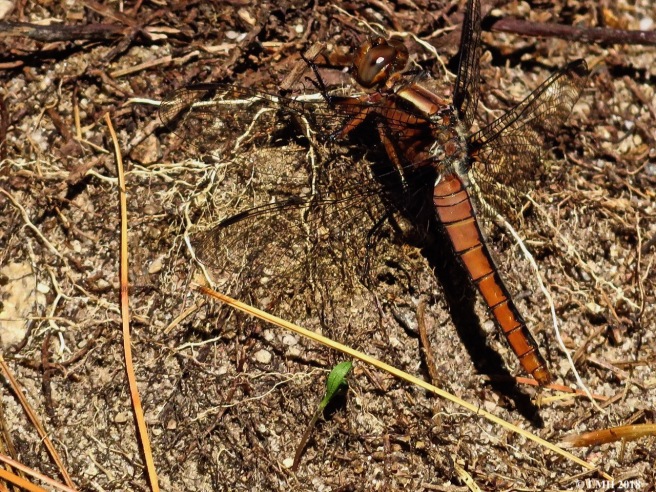The heron rookery was our destination and so friends Pam and Bob journeyed with me, our expectations high.

But as nature would have it, we’d barely walked fifty feet when our typical distraction disorder set in–and the focus encompassed the dragonflies that perched on foliage beside the trail. Our first was a Kennedy’s Emerald, named for Dr. Clarence Kennedy, a renowned Ohio State University professor and odonatologist.

Among the same fern patch was a Beaverpond Baskettail. It’s the eyes of this species that appealed to me most for I loved their teal color.

Every step we took seemed to produce a new combination of colors and presentations, all a variation on the dragonfly theme, including this immature Chalk-fronted Corporal.

And their names were equally intriguing, this one being a Mustached Clubtail.

It wasn’t just dragonflies patrolling the path and one mosquito at a time reducing the biting insect population–for damselflies also flew. When they weren’t canoodling that is. But canoodle away we said, for each interaction resulted in even more predators of our favorite kind.

And then . . .

and then we discovered a predator of another kind. And we rejoiced even more because for all the time we spend in the woods, sighting a gray tree frog is rather rare.

Not quite so rare, but beautiful in its unique form was the Ebony Jewelwing and her metallic colors. We spied one male with a white dot on his wings, but he escaped the camera lens.

It wasn’t just fliers and hoppers that caught our attention. Movement at our feet directed us to one who preferred to slither through the woods in garter formation.

And about a foot away from the parent–one of the young’uns.

At last we reached our destination and the real purpose for our journey. We were on a reconnoissance mission. Our job was to count nests, young and adults at a heron rookery for the Heron Observation Network of Maine–a citizen science adopt-a-colony network managed for Maine Inland Fisheries and Wildlife by biologist Danielle D’Auria. The project began after a significant decline in the number of nesting pairs of Great Blue Heron was realized in Maine from the 1980s to 2007, and MDIFW listed the bird as a Species of Special Concern.

Sadly, our count was zero for each category. While last spring the nests were active, something occurred and the colony collapsed before the young fledged last summer. Bald Eagles were the likely suspects of such a decline and as nature would have it, we thrilled with the resurgence of one species at the expense of another. Despite the current failure of the community, we’ll continue to visit each year . . . just in case.

But guess what? As we stood there, we noted the activity, or lack thereof, of mature Chalk-fronted Corporals–the female relaxing on the left and male on the right.

Every few seconds a Green Darner conducted its own reconnaissance mission.

And then some serious honking from upstream called for our attention.

And we were reminded of Bernd Heinrich’s book, The Geese of Beaver Bog, for we were in such a place.

At last, we pulled ourselves away, though I suspect we could have easily spent hours being mesmerized by the magic of the place. Such magic was reflected in the opaque wings of a newly emerged Kennedy’s Emerald dragonfly.

And on the way back, as often happens, we were privy to sights we’d missed on the way in. So it was that an Indian Cucumber Root displayed its unique flower–nodding pale green petals folded back, like a Turk’s cap lily, and from the center emerged three long reddish styles (think female reproductive parts) and several purplish orange stamens. Those styles gave the flower a unique spidery appearance.

And then . . . and then one more time not far from where we’d seen the gray frog on our way in, and mere moments after Pam said, “Where there’s one . . .” we found a second.
The heron rookery was our destination, but the trail to and fro offered so many moments of wonder.
Thank you to the family that conserved this land. Thank you to the wildlife in many forms who call it home. And thank you to Pam and Bob for not only accompanying me, but for insisting that I borrow your lightweight Canon Powershoot SX720HS. I might get hooked.

I love hikes like that: about 1 part hiking and 4 parts photographing the flora and fauna. Those gray frogs are really cool!
LikeLiked by 1 person
It was such a rare treat to see the tree frogs. Their camo is incredible.
LikeLiked by 1 person
So…I have to ask..were most of these from the canon or your phone? They are wonderful Leigh..either way…I love the colors of the forest floor, surrounding everything!
“I was so much older then, I’m younger than that now.” Bob Dylan
Sent from my iPad
>
LikeLiked by 1 person
So . . .since you asked, Pam, only two of the photos were from my phone–the rest were with the Canon. And it compensated well for my shakiness.
LikeLike
Leigh, what a wonder-full walk you had! Glad you had a substitute camera in hand. The pictures are so vivid, I felt like I was there. And great eyes, able to catch all those small and quick-moving fauna!
LikeLiked by 1 person
Thanks Murwat. Our hearts were smiling with the finds.
LikeLike